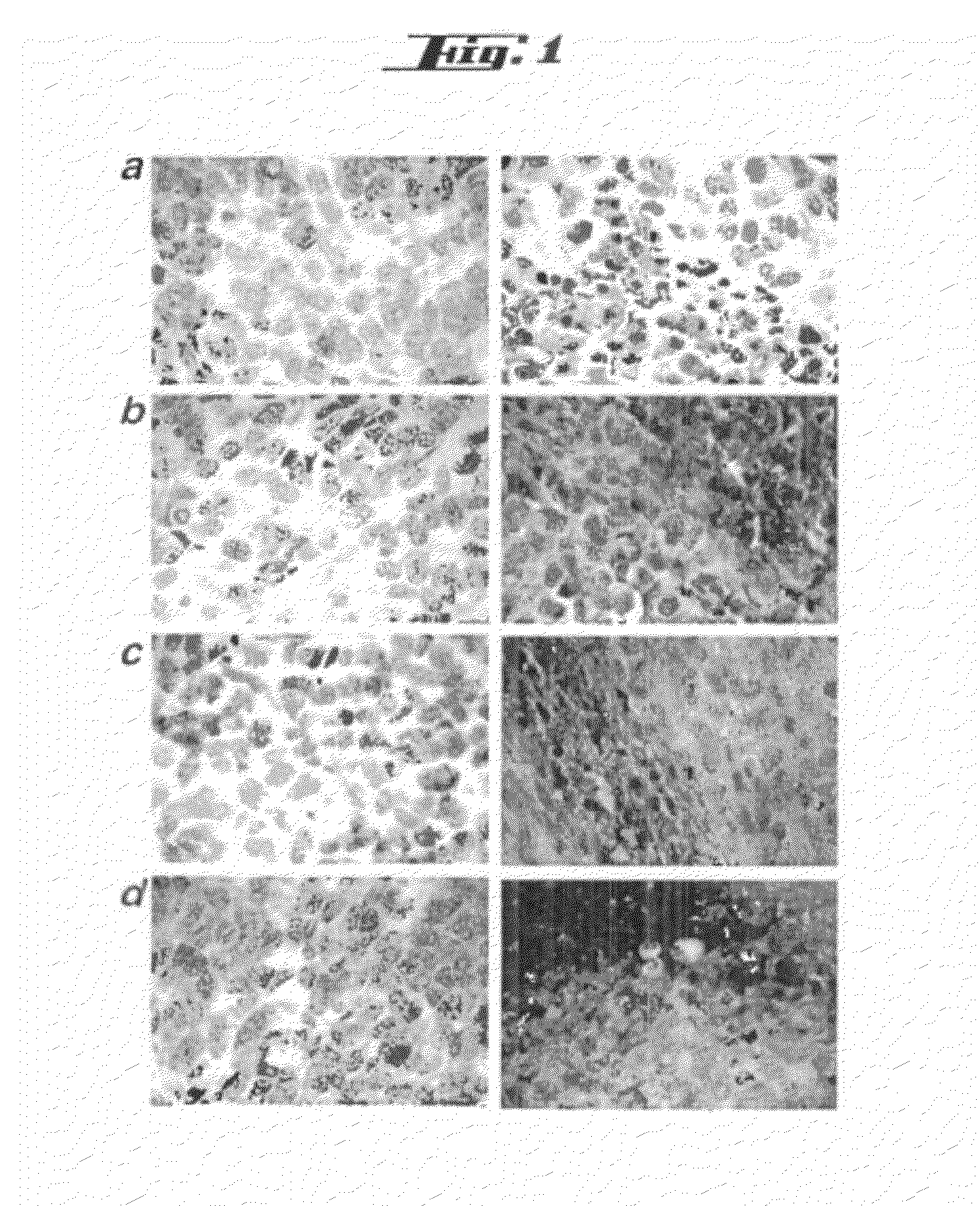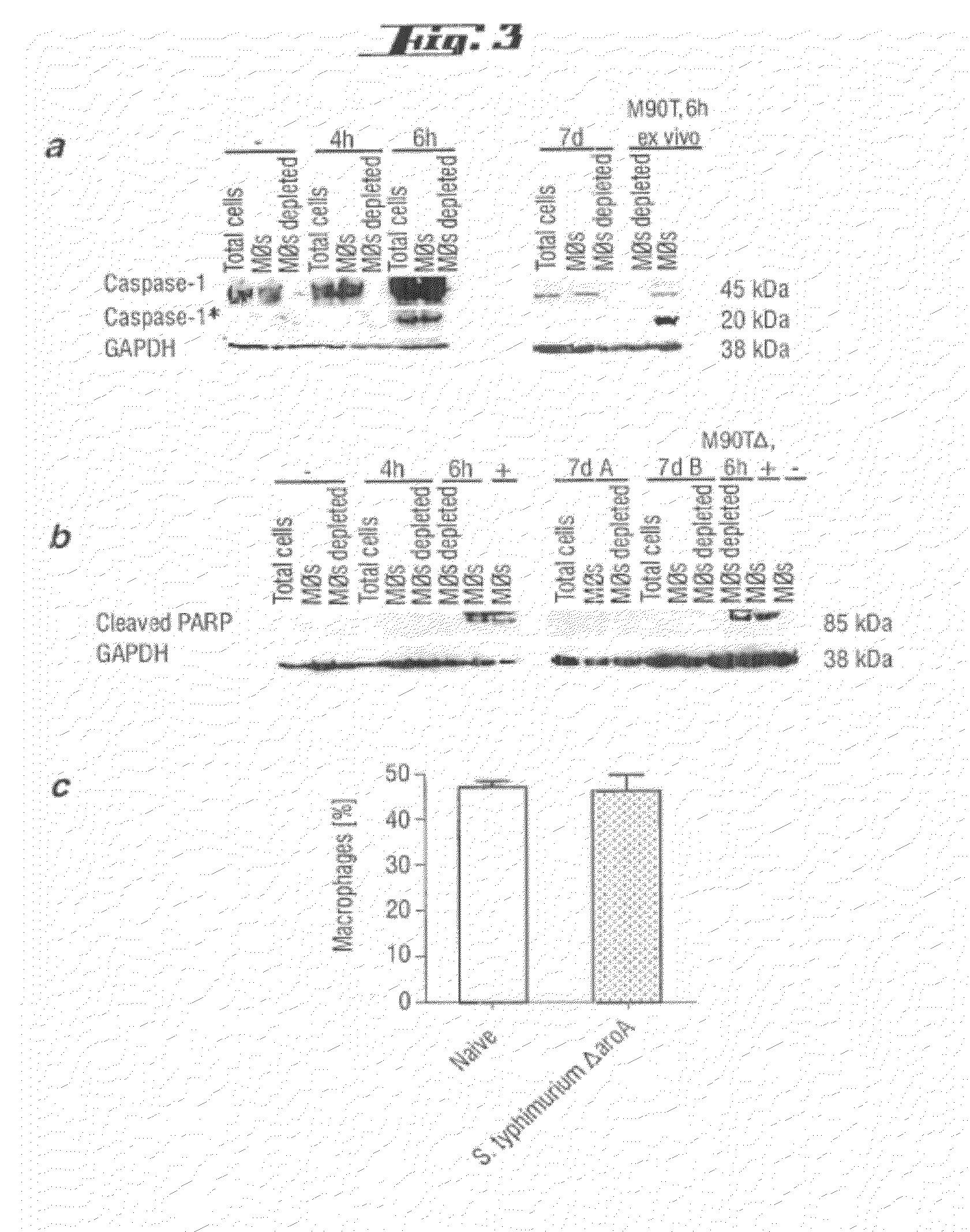Non-pathogenic and/or attenuated bacteria capable of inducing apoptosis in macrophages, process of manufacturing and uses thereof
a technology of attenuating bacteria and macrophages, which is applied in the field of attenuating bacteria capable of inducing apoptosis in macrophages, can solve the problems of slow blood flow, ineffective delivery of nutrients and oxygen to tumors or metastases, and low anti-tumor effect of i>salmonella /i> in humans,
- Summary
- Abstract
- Description
- Claims
- Application Information
AI Technical Summary
Benefits of technology
Problems solved by technology
Method used
Image
Examples
example 1
Methods
[0122]Plasmids. Escherichia coli strains carrying plasmids pKD3, pKD4 (Datsenko, K. A. & Wanner, B. L. Proc Natl Acad Sci U S A 2000, 97: 6640-6645), and pCP20 (Cherepanov, P. P. & Wackernagel, W. Gene 1995, 158: 9-14) were obtained from the Department of Biotechnology, University of Wuerzburg. The plasmids pKD3 and pKD4 are π dependent and carry chloramphenicol and kanamycin resistance genes, respectively, flanked by FLP recombinase recognition sites (FRT sites). The pCP20 plasmid contains a temperature sensitive replicon and the yeast FLP recombinase transcribed from the IpR promoter under the control of the I cI857 repressor (Cherepanov, P. P. & Wackernagel, W. Gene 1995, 158: 9-14).
[0123]Media, Chemicals and Other Reagents. Ampicillin-, chloramphenicol- (CmR), and kanamycin-resistant (KmR) transformants were selected on trypticase soy agar (1.2% agar) (TSA) (Difco Laboratories) containing the respective antibiotic at 100, 25, and 30 μg / ml. A total of 1 mM L-arabinose (Sig...
example 2
Expression and Secretion of the ipaB-gene (NC—004851) of Shigella flexneri in Gram Negative Bacteria (Escherichia coli K12)
[0159]2a) Cloning of ipaB-gene (NC 004851) of Shigella flexneri in Secretion Plasmid
[0160]Salmonella can like Shigella induce inflammation and apoptosis of infected macrophages through activation of caspase-1 mediated by the SipB protein, which is secreted via type III secretion systems (TTSS) (Suzuki, T. et al. J Biol Chem 2005, 280: 14042-14050; Zychlinsky, A. et al. Mol Microbiol 1994, 11: 619-627; Chen, L. M. et al., Mol Microbiol 1996, 21: 1101-1115; Hilbi, H. et al. J. Biol. Chem. 1998, 273: 32895-32900). Salmonella activate caspase-1 by SipB and induce apoptosis in TAMs at early, but not late timepoints and failed to reduce the relative amounts of TAMs. In contrast, metabolically attenuated, virulent Shigella strains, but not avirulent Shigella strains, are able to activate caspase-1 and induce apoptosis in TAMs by IpaB at all timepoints in the 4T1 and th...
PUM
| Property | Measurement | Unit |
|---|---|---|
| incubation time | aaaaa | aaaaa |
| temperature | aaaaa | aaaaa |
| concentration | aaaaa | aaaaa |
Abstract
Description
Claims
Application Information
 Login to View More
Login to View More - R&D
- Intellectual Property
- Life Sciences
- Materials
- Tech Scout
- Unparalleled Data Quality
- Higher Quality Content
- 60% Fewer Hallucinations
Browse by: Latest US Patents, China's latest patents, Technical Efficacy Thesaurus, Application Domain, Technology Topic, Popular Technical Reports.
© 2025 PatSnap. All rights reserved.Legal|Privacy policy|Modern Slavery Act Transparency Statement|Sitemap|About US| Contact US: help@patsnap.com



